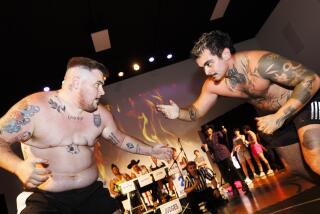Drumbeat of Men’s Movement Reaches Beyond Yuppie Tribe : ‘I learned growing up it was OK to stick a helmet in a guy’s gut, but it wasn’t OK to hug them.’
The group is still at it, writhing on the ground and grunting, beating on drums and dancing in the candlelight to affirm their masculinity. A few years after devotees of the so-called men’s movement were first publicized, and parodied, a group of computer programmers, accountants and business consultants continue to gather weekly in Long Beach to cope with the trials and tribulations, the sorrows and satisfactions, of being middle-class white guys in 1993.
Eric Dabrowski, the leader of this group at Phoenix--A Center for Men, says while these sessions are still popular, the men’s movement recently has broadened its focus and its constituency. The movement wants more than just a few good--but frustrated--men. The movement is recruiting minority men and gay men and young men and old men.
Last year more than 100 African-American and Latino men went on a weeklong retreat in Malibu that was sponsored by a men’s movement leader, Dabrowski said. A national multicultural men’s conference is scheduled for next year.
The movement also is searching out confused younger men, who grow up into confused middle-aged men, because they have never learned from their fathers how to be manly men. Dabrowski belongs to an “initiation group” that recently returned from the mountains where fathers initiated sons into manhood by sweating with them in Indian sweat lodges, listening to an African shaman relate initiation tales and then sending the boys out to spend the night in caves.
The men’s movement--like most other movements--has victims and victimizers. The victims, obviously, are men. And the victimizers are . . . moms.
According to the male manifesto “Iron John” by Robert Bly, fathers have been so busy working, mothers have raised a generation of wimps and dweebs--”soft men,” he calls them. Mothers simply did not know how to induct their sons into manhood so they could discover their “hairy wild man” side and “kingly” nature.
But now the men’s movement is doing what would have once been unthinkable, said Siavash Tabrizy, program director at the Phoenix Center, located in an office complex on Long Beach Boulevard. After spending years in therapy groups complaining about their moms, their girlfriends and their wives, men are now inviting the enemy into their camp.
There are now men’s groups for women.
*
The men at the Thursday night “mytho-poetic” group at the Phoenix Center remove their shoes, gather in a circle around a candle--to simulate a campfire--and begin drumming and chanting.
“This calls the tribe of men together into the men’s lodge” says Dabrowski, 44, a therapist with a small ponytail who is such an enthusiast of men’s groups that he attends a men’s group for leaders of men’s groups.
When the drums are put away, the men talk and “unburden themselves of the baggage of everyday life,” he says. After men relate stories of unsympathetic girlfriends, bullying bosses and problems with rental units, the others in the group somberly nod their heads and say “Ho” in unison. “Ho” is an Indian word, Dabrowski says, that means, “I hear you.”
The group breaks out of the circle, Dabrowski plays a
New Age tape and as the men begin writhing to the music, he tells them: “Be aware of how you’re prisoners in your bodies. . . . Imagine breaking free.” They soon converge and move together because Dabrowski wants them to make physical contact with other men’s bodies “in order to obtain male nurturing.”
He shouts: “Express the wild man within you!” The men begin yelling and stomping and grunting and rolling around the ground.
After they return to the circle and burn sage in an Indian cleansing ceremony, Dabrowski “calls on the spirit of the masculine” and suggests they get in touch spiritually with their fathers and grandfathers. He tells stories leavened with masculine images and finally passes around an Indian “talking stick.” He instructs the men to interpret the story in a way that evokes “their journey in manhood.” The purpose of all the Indian imagery, Dabrowski says, is to “connect the men deeply to the earth.”
At the end of the session, after some vigorous hugging, John Smith, a workers’ compensation claims examiner from Westminster, says he never knew how to hug before he joined the group.
“I learned growing up it was OK to stick a helmet in a guy’s gut,” he says, “but it wasn’t OK to hug them.”
Another man in the group, a business consultant from Long Beach, says he joined the group because he wanted to relate better to other men, but not in a “beer-guzzling, drunken sort of way.” And he wanted to explore the facets of his masculinity that are “wild and energetic, passionate and fierce.” He wanted to learn more about his “warrior side.”
But after the meeting the warrior has to climb back in his car, leave the world of heroic masculinity and return to a life where he has to wash the dishes, balance his checkbook and take out the garbage.
Ho.
More to Read
Sign up for Essential California
The most important California stories and recommendations in your inbox every morning.
You may occasionally receive promotional content from the Los Angeles Times.










